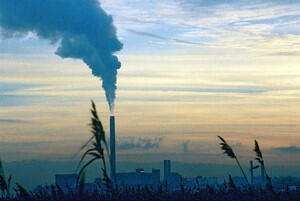It does not include the emissions of methane from cattle, for example. Nor does it factor in the impact on CO2 of deforestation. Now, the bad news. We are in the deepest recession since the 1930s. Industrial output in the energy-hungry west has dropped. In the USA, for example, emissions are back down to 1995-6 levels. So the 0.1% fall globally really disguises a continuing underlying upwards trend. Indeed in previous economic downturns the fall in CO2 emissions was much more marked. This was the case in 1981-83 and in 1991-92. However, on each of these occasions economic recovery saw the upward trend in CO2 re-established.
The growth of China and India is fundamental to the future of global CO2 emissions. From 2008 to 2009, China’s emissions leapt by over 13%. Let’s put it another way, in that one year the increase in emissions from China came to more than the total amount as the emissions from Germany, Norway, Sweden, Estonia, Latvia and Lithuania combined. China’s totals CO2 emissions in 2009 came to 7,711 million tonnes. This compares with 5,425 million tonnes for the USA. At the moment India is well behind at 1,602 million tonnes, though significantly it overtook Russia to claim third place in the world league of total emissions. India’s rate of increase in 2009 was 8.7%. At that growth rate India’s total amount of emissions will more than double by 2018.
Emissions per person
Of course, total emissions partly reflect the size of the country: other things being equal big countries with more people produce more emissions. The table below, constructed from the US Energy Information Administration website, gives a fuller picture.
|
Country |
CO2 emissions 2009 (M tonnes) |
% Change since 2008 |
Population 2009 (000s) |
CO2 Tonnes per person 2009 |
|
China |
7711 |
+13.3 |
1,323,592 |
0.006 |
|
India |
1602 |
+8.7 |
1, 156,898 |
0.001 |
|
USA |
5425 |
-7.0 |
307,007 |
0.018 |
|
Estonia |
17.5 |
-11.8 |
1,299 |
0.013 |
|
Finland |
52.2 |
-5.0 |
5,250 |
0.010 |
|
Germany |
766 |
-7.0 |
82,330 |
0.009 |
|
Latvia |
8.5 |
+8.1 |
2,232 |
0.004 |
|
Lithuania |
15.8 |
-12.9 |
3,555 |
0.004 |
|
Norway |
39.6 |
-0.3 |
4,661 |
0.008 |
|
Poland |
286 |
-3.7 |
38,483 |
0.007 |
|
Russia |
1572 |
-7.4 |
140,041 |
0.011 |
|
Sweden |
50.6 |
-7.7 |
9,060 |
0.006 |
From the table we can see that in terms of per capita emissions, the US is still way ahead of China, which in turn produces something like 6 times the emissions per person as India. What is striking is that China and Sweden now come out level, with Sweden succeeding in cutting its per capita emissions while China’s continues to rise steeply. However, China remains well below Russia and Estonia. Latvia and Lithuania emerge as the “greenest” two countries in the Baltic on this measure. Each of their residents is produces about half the emissions of a typical Norwegian.
The data on the change since 2008 needs to be seen in the context of the recession, rather than a basis for projection. Thus Norway appears to have made very little progress – or to have suffered much less from the global economic downturn than its neighbours. However, the figure that leaps out is the one for Latvia, which despite the recession has seen a significant rise in its CO2 emissions since 2008. The explanation seems to be that Latvia got hit by the recession sooner than its neighbours. The change in is emissions between 2007 and 2008 was very steep – a reduction of 14%. Over the same year Lithuania had a rise of 2.5%, only to be followed by a drop of 12.9% the following year.
Conclusions
The fate of the planet hangs on what China does next. OK, that is an overstatement, but like many sweeping generalisations it contains some truth. The science that has demonstrated empirically and theoretically the links between CO2 emissions and climate change, suggests that the growth of CO2 emissions globally needs to be reversed. The recession began with the collapse of the banks in 2008 and has wiped out many economic activities since then. This has done more than green initiatives to deflect us from the energy path we were on. However, evidence from the past is that with recovery will come another sharp rise in emissions. Meanwhile, China is on a roller coaster of CO2 intensive growth, with India following though some way behind.
The message for people in the towns and villages of Europe is not that we should do nothing but cross our fingers and hope that China changes course. Rather, we should look at ways that nationally, locally and personally we can reduce CO2 emissions. China is well aware that it must change and is actively investing in research into ways to do so. Variations in CO2 per capita between the Baltic nations show that high income does not necessarily directly translate into high emissions. IC members can demonstrate that in practice by the way they plan, develop and regulate their towns and regions.

